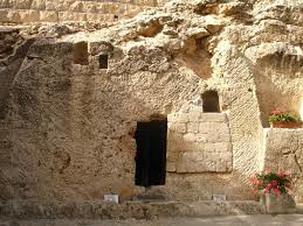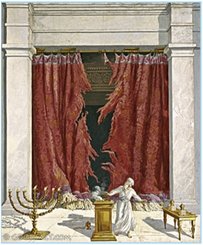
Then cometh Simon Peter following him, and went into the sepulchre, and seeth the linen clothes lie, And the napkin, that was about his head, not lying with the linen clothes, but wrapped together in a place by itself. Then went in also that other disciple, which came first to the sepulchre, and he saw, and believed. (John 20:6-8) This was a miracle of Calvary.
Let us be quick to understand that the Scriptures are on a par with other sources of history that rely upon personal testimony and written records to establish truth. The Bible is not an unclaimed orphan when it comes to holding its own as a reliable source of true history. There was not one, but four Gospels, written and examined by church counsels to establish their place in Biblical canon. The Gospels do not contradict each other, but rather, complement each other in establishing a completed account of the life, death, and resurrection of Jesus Christ.
The sketch of Jesus’ grave clothes, above, gives a good approximation of the reality. The Jewish method of preserving bodies was quite different from the Egyptian method. It took about one hundred pounds of spices to properly prepare a body by the Jewish method. This varied some as to how the idea was applied. Some sources say that the Jews laid strips of cloth long-ways on the body.
Others hold that the body was wrapped round and round. Round and round is a much stronger way of applying the same amount of cloth and would hold the spices in place better than applying the cloth lengthways. Art work on the grave clothes of Jesus is scarce and most of it portrays the grave clothes wound around the body.
The Scriptures portray the three hours of darkness, the victory cry from the cross, the rending of the veil in the Temple, the earthquake, the opening of graves, and now we look at the brief mention of His grave clothes.
John does not dwell on the miracles of Calvary but in one brief statement tells us that the linen clothes were lying together in one place and the head wrapping, still wrapped together in a place by itself. The grave clothes are not unwrapped and hurriedly dropped to the floor but are neatly in place like they were place with the body in them. It infers that the grave clothes were lying precisely as the body had lain there.
“In the record, there is no mention of the clothes being unwrapped. The head wrapping is still a head wrapping and separate from the rest of the clothes. With the body removed, the windings of cloth would have collapsed somewhat because of the hundred pounds of spices applied to the linen cloth. None of the fastenings had been loosed, no bandage undone, none of the folds disturbed, no change in position. No change except the body had somehow come out of the wound cloth and spices, leaving the empty shell.
Luke corroborates John’s story by saying that the linen clothes were “lying by themselves.” (Luke 24:12)
“The natural body had dissolved within its wrappings and become merged in the spiritual body, a transmutation that no fastenings could tie down. It vanished from within the graveclothes and moved on its way to the stone at the door of the sepulcher (which had not yet been removed). Though the rising of His body is mentioned in many places in the Bible, the act of His rising is never mentioned. It simply says: “He is risen!” (The writers of John and Luke took no license to fill in the details with their imaginations.)
“If the friends of Jesus had taken away His body, they would not have removed the clothes from His body. If His enemies had taken his body and for some reason removed the clothing, they would not have neatly arranged them to resemble His body. Indeed, no human hands could have abstracted the body from its clothes without leaving behind marks of disturbance on bandage and fold.” (Nicholson, edited slightly.)
The arguments that Jesus merely “swooned” or that His disciples stole His body have not convinced the many millions of people who have believed that He genuinely died, was buried, and rose again on the third day. (In the Jewish way of listing days, each day was automatically joined to a night to complete the obvious 24-hour cycle. The days were: Friday, Saturday, and Sunday. Mentioning a day-and-night did not mean a 12-hour day and a 12-hour night. Jonah and Jesus are related in a “three days and three nights” space of time.) There was never a major Jewish charge that the three days and three nights was a conflict with the Jewish way of counting time. This has bothered some people, so I mention it here.
Read Through the Bible in a Year
MAY 1, 2017 - MONDAY
A.M. 1Kings 1-2 P.M. Luke 22:54-71
(Bible Gateway will read this to you if you like. Look for the speaker icon.)
Memory Verse This Month:
And he said unto them, These are the words which I spake unto you, while I was yet with you, that all things must be fulfilled, which were written in the law of Moses, and in the prophets, and in the psalms, concerning me. (Luke 24:44)
Song for Today:
How Great Thou Art (6:07) (FBC -Jax, FL)
https://www.youtube.com/watch?v=2iqtCTtVIB4









 RSS Feed
RSS Feed
